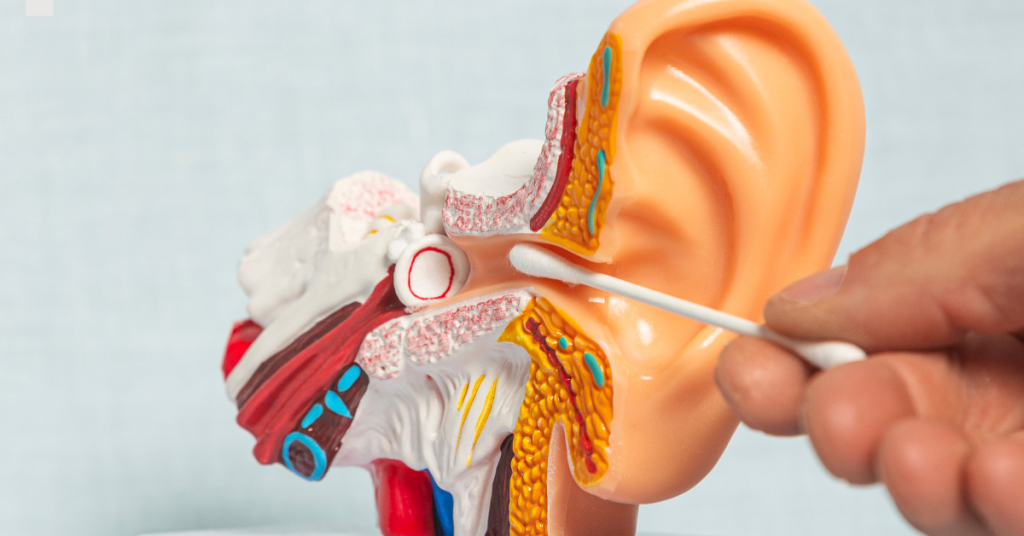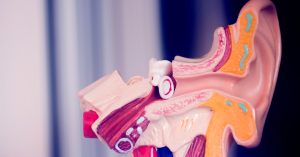Earwax, also known as cerumen, might not be a popular topic of conversation, but it plays a crucial role in ear health. Most of the time, this waxy substance quietly does its job—trapping dust and debris, keeping the ear canal moist, and helping to prevent infections. However, when too much earwax builds up or becomes impacted, it can lead to a range of uncomfortable symptoms and even affect hearing.
Earwax blockage is a common issue, particularly among older adults and those who use hearing aids, earbuds, or cotton swabs regularly. Understanding why earwax builds up and knowing how to deal with it safely is essential for maintaining good hearing and overall ear health. In this article, we’ll explore what causes earwax blockage, the symptoms to watch out for, and safe at-home and professional solutions. Whether you’re experiencing discomfort or simply want to learn how to prevent issues in the future, this guide offers expert-backed advice to help you care for your ears properly.
What Is Earwax and Why Do We Have It?
Earwax, or cerumen, is a natural substance produced by glands in the outer part of your ear canal. Despite its reputation, earwax is not something to be feared or eliminated entirely. In fact, it plays a critical role in protecting your ears from damage and infection. Its sticky texture traps dust, microorganisms, and other foreign particles before they can reach the more sensitive parts of the ear. It also has antibacterial and antifungal properties that help ward off infections.
Another important function of earwax is lubrication. A well-lubricated ear canal prevents dryness and itchiness, which can be both uncomfortable and a risk factor for further problems like scratching and infection. Normally, earwax gradually makes its way to the opening of the ear, where it dries and falls out or gets washed away during regular bathing. This self-cleaning mechanism means that, in most cases, no special cleaning is necessary.
Problems begin when this natural process is disrupted. Factors such as aging, excessive earwax production, or interference with the ear’s natural cleaning (for example, by using cotton swabs) can lead to buildup and blockage. When earwax becomes impacted, it stops functioning properly and can start to cause symptoms like hearing loss, discomfort, or even dizziness. Understanding how and why this buildup occurs is the first step in preventing and managing earwax-related issues.
Common Causes of Earwax Blockage
While earwax typically exits the ear canal on its own, a variety of factors can disrupt this natural process and lead to a blockage. Understanding what contributes to earwax buildup is key to preventing discomfort and potential complications.
One of the most common culprits is the use of cotton swabs or other objects to clean the ears. Although many people believe they’re helping by removing wax, these tools often push wax deeper into the ear canal, compacting it against the eardrum. This not only increases the risk of blockage but can also damage the delicate structures of the ear.
Another frequent cause is the regular use of hearing aids, earplugs, or earbuds. These devices can prevent earwax from naturally exiting the ear canal and may also stimulate increased wax production. Over time, this buildup can harden and become difficult to remove without professional help.
Some individuals naturally produce more earwax than others, which can lead to a higher likelihood of blockage. The consistency of the wax also matters—drier, harder wax is more prone to impaction. This is especially common in older adults, whose glands may produce less oily wax as they age.
Anatomy plays a role too. People with narrow or unusually shaped ear canals may find it harder for earwax to move out naturally, leading to accumulation. Certain skin conditions like eczema or infections can also alter the composition of earwax, contributing to blockages.
In short, earwax blockage is often the result of a combination of behavior, biology, and environment. Recognizing these causes can help you adopt better habits and seek appropriate care when needed.
Signs and Symptoms of Earwax Blockage
Earwax buildup doesn’t always cause noticeable problems, but when it becomes excessive or impacted, a variety of symptoms can emerge—some subtle, others more disruptive to daily life. Recognizing these signs early can help you take the right steps to address the issue safely.
One of the most common symptoms of earwax blockage is reduced or muffled hearing in the affected ear. This type of hearing loss tends to come on gradually and can be mistaken for age-related hearing changes. You might notice you’re turning up the volume on the television more often or asking others to repeat themselves. Unlike hearing loss caused by inner ear damage, earwax-related hearing loss is usually temporary and resolves with proper removal.
Other frequent signs include a feeling of fullness or pressure in the ear, which can be mildly annoying or quite uncomfortable. Some people also report ear pain or a throbbing sensation, especially if the wax is pressing against the eardrum. In some cases, ringing in the ear (tinnitus) can develop or worsen due to the blockage.
Interestingly, impacted earwax can also cause dizziness or imbalance, as the buildup may affect the ear’s role in maintaining equilibrium. And because of the ear’s close connection to the nerves in the throat, it’s not uncommon to experience a chronic cough triggered by the wax pressing on certain nerves.
It’s important to note that symptoms like severe pain, drainage from the ear, or fever are not typical of simple earwax blockage and may signal an infection or another more serious issue. If you’re experiencing these symptoms, it’s best to seek medical attention promptly.
Knowing these signs can help you distinguish between minor buildup and more significant concerns that require professional evaluation.
Safe At-Home Remedies for Earwax Removal
For many people, minor earwax buildup can be managed effectively and safely at home—provided you use the right methods. The key is to avoid aggressive techniques and instead rely on gentle, medically recommended approaches.
One of the safest and simplest methods is to soften the earwax using over-the-counter ear drops. These often contain ingredients like carbamide peroxide, hydrogen peroxide, saline, or mineral oil, which help break down hardened wax and make it easier for the ear to expel it naturally. To use them, lie on your side with the affected ear facing up, place a few drops into the ear canal, and stay in that position for several minutes. Then, sit up and wipe away any softened wax that may drain out.
Another method involves gently rinsing the ear with warm water. This can be done using a rubber bulb syringe, which allows you to squirt a controlled stream of water into the ear canal after softening the wax. The water should be body temperature—too hot or too cold can cause dizziness. After rinsing, tilt your head to let the water and loosened wax drain out.
It’s crucial to avoid inserting cotton swabs, bobby pins, or any objects into the ear canal. These tools can push wax deeper, increase the risk of impaction, or even cause injury to the eardrum. Ear candles, another commonly marketed remedy, are not only ineffective but also dangerous and strongly discouraged by medical professionals.
Some people find success with natural oils like olive oil or almond oil to soften wax, though these should be used cautiously and never if you have a history of ear infections or a perforated eardrum.
If at-home remedies don’t provide relief after a few days, or if you’re experiencing symptoms like significant hearing loss or pain, it’s time to consult a professional. Safe home care can be effective, but it’s not a substitute for expert help when needed.
When to See a Professional for Earwax Removal
While many cases of earwax buildup can be managed safely at home, there are times when professional help is not only recommended but essential. Recognizing when to seek medical care can prevent complications and ensure that your ears stay healthy.
You should see a healthcare provider if you’re experiencing persistent symptoms, such as significant hearing loss, ongoing discomfort, or a sensation of fullness that doesn’t improve after trying at-home treatments. Pain, drainage, or bleeding from the ear are also red flags that should never be ignored, as they could indicate an infection, a perforated eardrum, or another underlying issue unrelated to wax.
People who use hearing aids or earbuds regularly may be more prone to wax impaction and should consider regular ear checkups to maintain optimal hearing. The same goes for individuals with recurrent earwax problems, narrow ear canals, or a history of ear surgeries or infections. Attempting self-care in these situations can do more harm than good.
Medical professionals, including audiologists, general practitioners, and ENT (ear, nose, and throat) specialists, have the training and tools to remove earwax safely. Common in-office methods include:
- Irrigation: A controlled flow of warm water is used to flush out the wax.
- Suction (microsuction): A gentle vacuum removes wax under direct visualization with a microscope.
- Manual removal: Special instruments like curettes are used to extract wax precisely and carefully.
These techniques are much safer than self-attempted removal and are particularly important for those with delicate ear structures or medical conditions affecting the ears.
Seeking professional care isn’t a sign of failure—it’s a smart move to preserve your hearing and prevent long-term damage. If you’re unsure whether your symptoms are due to wax or something else, a professional exam is the best way to get clarity and peace of mind.
Prevention Tips to Avoid Future Blockages
Preventing earwax buildup before it becomes a problem is not only possible—it’s often simpler than you might think. With a few mindful habits and some basic ear care, you can reduce your chances of experiencing discomfort or hearing loss due to impacted wax.
One of the most important tips is to avoid inserting anything into your ears, including cotton swabs. Despite their widespread use, these tools often do more harm than good by pushing wax deeper into the ear canal. The ear is self-cleaning, and regular bathing is usually sufficient to manage wax that naturally migrates to the outer ear.
If you’re prone to buildup, consider using earwax-softening drops on a regular basis as a preventative measure. These can help keep wax soft and mobile, reducing the likelihood of impaction. However, these should only be used as directed and avoided altogether if you’ve had ear surgery or suffer from chronic ear conditions.
For individuals who wear hearing aids, earbuds, or in-ear monitors, it’s important to clean these devices regularly and allow your ears some time without them each day. These items can trap wax and block its natural exit path, making impaction more likely.
Regular checkups with your healthcare provider or audiologist can also help. They can examine your ears during routine visits and recommend professional cleaning if needed. This is especially valuable for older adults, who may produce drier wax that doesn’t exit the ear as easily.
Environmental factors can also contribute to wax issues. If you work in dusty or dirty environments, protective ear coverings can help prevent debris from entering your ears and triggering wax overproduction.
Finally, listen to your ears. If you start to notice hearing changes, itchiness, or a sense of fullness, don’t ignore it. Early action can prevent a small issue from becoming a bigger problem.
By following these preventive strategies, you can maintain ear health and minimize the risk of wax-related complications down the road.
Conclusion
Earwax might not be the most glamorous subject, but it’s an essential part of our ear health—and something that deserves attention, especially as we age. While earwax generally takes care of itself, understanding the causes and symptoms of blockage can help you avoid discomfort and protect your hearing.
From overuse of cotton swabs to the impact of hearing aids and natural aging, many factors can contribute to wax buildup. Knowing the signs—such as muffled hearing, fullness in the ear, or ringing—and how to manage them with safe, at-home remedies is key. Equally important is recognizing when it’s time to consult a healthcare professional for removal.
With the right knowledge and habits, you can keep your ears healthy and your hearing clear. Regular monitoring, gentle care, and avoiding common mistakes can go a long way in preventing earwax-related issues. Don’t wait until you experience a problem—being proactive about ear health is one of the simplest ways to preserve your quality of life.
FAQ
What causes excessive earwax production?
Excessive earwax can result from overactive glands in the ear canal, frequent use of earplugs or hearing aids, or irritation from objects like cotton swabs. Some people naturally produce more earwax than others, and aging can also cause wax to become harder and drier, making buildup more likely.
Is it safe to use cotton swabs to clean my ears?
No. Cotton swabs can push earwax deeper into the canal, increasing the risk of blockage or damaging the eardrum. Medical professionals strongly advise against inserting anything into the ear canal. Instead, clean only the outer ear with a soft cloth.
How can I tell if my hearing loss is due to earwax or another issue?
Earwax-related hearing loss tends to come on suddenly and is often accompanied by a feeling of fullness in the ear or mild discomfort. If cleaning your ears doesn’t restore hearing or if you notice persistent symptoms, a professional exam can determine the true cause.
Are ear candles a safe way to remove earwax?
No. Ear candling is not a medically approved treatment and has been shown to be ineffective and potentially dangerous. It can cause burns, ear canal blockages, or even perforation of the eardrum. Safer alternatives include ear drops, irrigation, or professional removal.
How often should I have my ears checked for wax buildup?
It depends on your individual risk factors. People who wear hearing aids, frequently use earbuds, or have a history of wax impaction may benefit from annual checkups. Your healthcare provider can help determine the right schedule for you.
“This article is for informational purposes only and is not a substitute for professional medical advice, diagnosis, or treatment. If you are concerned about your hearing or ear health, please consult a qualified healthcare provider.”






